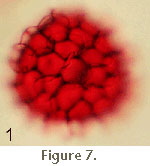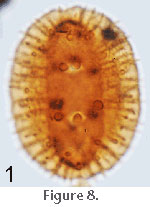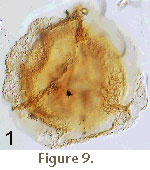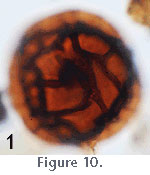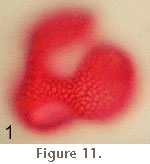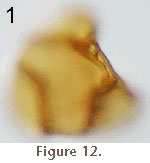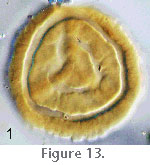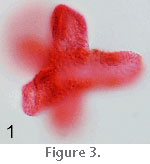These palynofloras display a great diversity of morphological types with excellent preservation quality, which makes them ideal candidates to evaluate the performance of depth of field reconstruction for each case. Each palynomorph is depicted on a series of pictures representing the individual optical sections used for reconstruction from bottom to top. The reconstructions are shown at the end of the sequence as well and commented below.
•
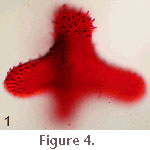 Example of
Figure 3 and
Figure 4 shows two triprojectate pollen grains (Aquilapollenites quadricretaeus and Aquilapollenites attenuatus) from the Hell Creek flora. The very complex three-dimensional structure makes them spectacular and convincing candidates for depth of field correction. Using the "Do Stack" macro efficiently combines all of the frames into a single comprehensive image preserving all the details and ornamentation of the exine.
Example of
Figure 3 and
Figure 4 shows two triprojectate pollen grains (Aquilapollenites quadricretaeus and Aquilapollenites attenuatus) from the Hell Creek flora. The very complex three-dimensional structure makes them spectacular and convincing candidates for depth of field correction. Using the "Do Stack" macro efficiently combines all of the frames into a single comprehensive image preserving all the details and ornamentation of the exine.
•
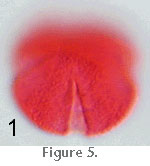 Depending on the mounting medium used for preparing the palynological slides, palynomorphs can more or less frequently be situated in an unfavorable position, not lying flat in the plane perpendicular to the optical axis. For example,
Figure 5 (Nyssapollenites spp.) shows that the use of depth of field reconstruction is very efficient in compensating for this problem.
Depending on the mounting medium used for preparing the palynological slides, palynomorphs can more or less frequently be situated in an unfavorable position, not lying flat in the plane perpendicular to the optical axis. For example,
Figure 5 (Nyssapollenites spp.) shows that the use of depth of field reconstruction is very efficient in compensating for this problem.
•
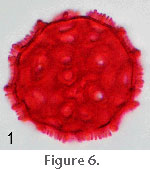 Palynomorphs with very developed external sculptures also benefit from depth of field reconstruction. Four examples are given, 1) Erdtmanipollis cretaceus (Figure 6) with a wellpronounced crotonoid sculpture, 2) Retitriletes spp. (Figure 7) with a reticulate scultpure, 3) Wodehouseia spinata (Figure 8) with echinate sculpture, and 4) Aequitriradites spp. (Figure 9) with reticulate-spinulose sculpture. More care should be taken in the selection of input frames for processing. Variable results can be obtained when patterns tend to overlap. The use of only a limited number of optical sections may help.
Palynomorphs with very developed external sculptures also benefit from depth of field reconstruction. Four examples are given, 1) Erdtmanipollis cretaceus (Figure 6) with a wellpronounced crotonoid sculpture, 2) Retitriletes spp. (Figure 7) with a reticulate scultpure, 3) Wodehouseia spinata (Figure 8) with echinate sculpture, and 4) Aequitriradites spp. (Figure 9) with reticulate-spinulose sculpture. More care should be taken in the selection of input frames for processing. Variable results can be obtained when patterns tend to overlap. The use of only a limited number of optical sections may help.
• Figure 10,
Figure 11,
Figure 12, and
Figure 13 depict a series of palynomorphs with a different structure between the proximal and distal poles. Here, the "Do Weighted Average" macro was tested on all optical sections. As can be seen, it is not now possible to distinguish ornamentation that occurs on the proximal pole from that occurring on the distal pole. Separating the input images into two sets may be necessary to describe some palynomorphs fully without presenting a false image of everything stacked in a single plane.
